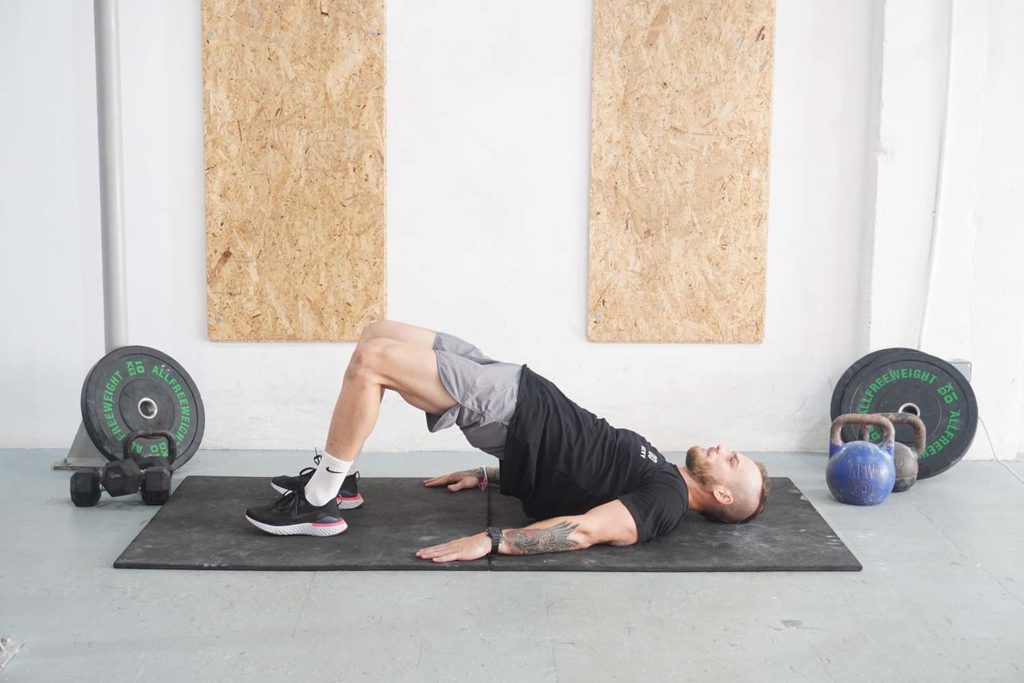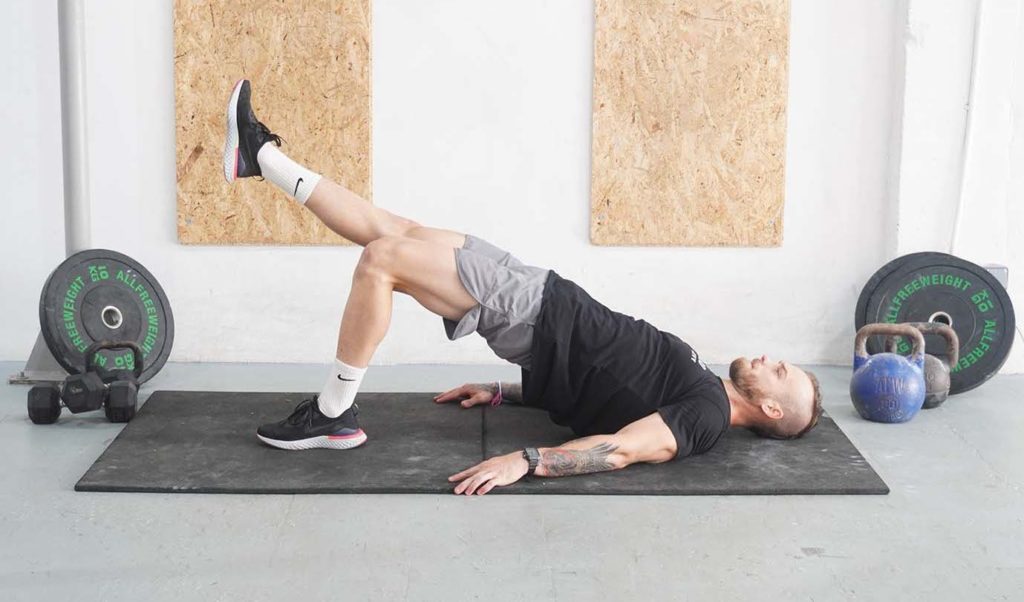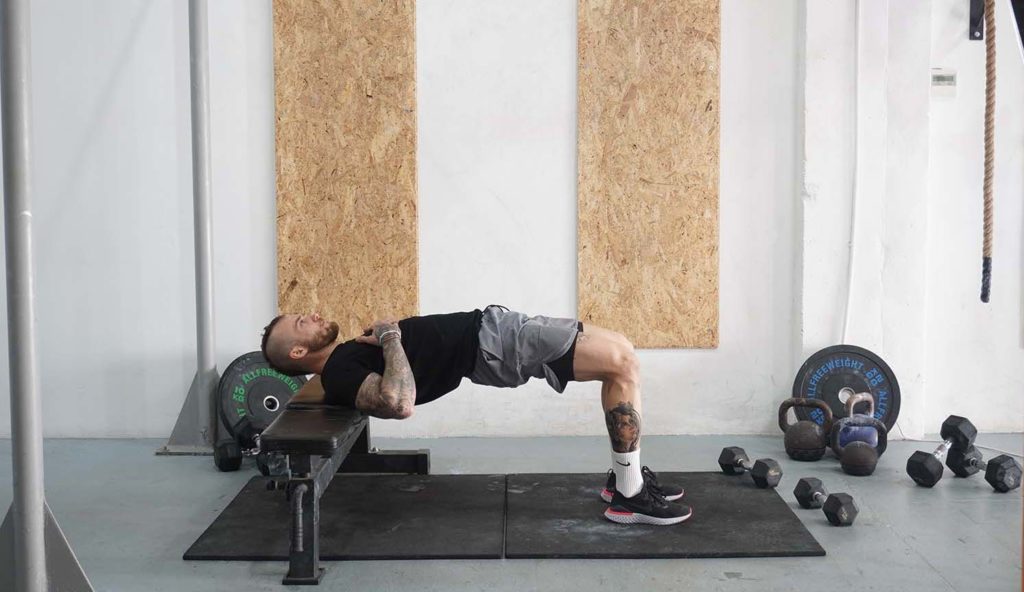The Benefits of the Single Leg Glute Bridge
The single-leg glute bridge is an effective exercise for developing your posterior chain: the hamstrings, glutes, and lower back. Training one leg at a time is beneficial for preventing and fixing muscle imbalances, which often lead to visual disproportions, impaired athletic ability, and a higher risk of injuries.
Like the regular glute bridge, the objective is to engage your posterior muscles and practice hip extension while lying on the floor. But, you must support yourself on one foot, which makes the exercise more challenging and beneficial.
A notable benefit of performing unilateral exercises (training one side at a time) is that you develop your muscles more evenly, leading to more athleticism and functionality to perform everyday tasks with ease.
We recommend including the single-leg glute bridge early in your training and doing as many slow and controlled repetitions as possible. Once you become proficient, you can move the exercise to the middle or end of your lower body workouts.
Level of Exercise: Intermediate
How to do a Single-Leg Glute Bridge
- Place an exercise mat and lie down with your arms to your sides and hands flat on the floor.
- Bend your knees and place your feet flat on the floor, a few inches away from your buttocks.
- Raise one leg in the air and bend the knee at a comfortable angle.
- Take a breath and press through the heel of your other foot, engaging your posterior chain to drive your hips in the air.
- Extend your hips until they are in line with your knee and shoulders.
- Hold the top position for a moment and lower your buttocks to the floor, exhaling on the way down.
- Perform as many slow and controlled reps as possible.
- Anchor the foot you previously had in the air and raise the opposite one.
- Perform the same number of repetitions and take a break.
What muscles does a single leg glute bridge activate?
The primary muscle that works during the single-leg glute bridge is the gluteus maximus, which makes up a large percentage of the buttocks and produces hip extension (1, 2). Our glutes engage off the bottom position and drive our hips to the top of each repetition, where they achieve peak activation. Similarly, the hamstrings assist the glutes with hip extension (3). The muscle covers the posterior of our thighs and produces force to drive our hips up.
Glute bridges are also beneficial for developing the erector spinae muscles that run along both sides of the spine. The muscle group serves essential roles related to spinal stability and health.
Our midsection musculature also contributes during the single-leg glute bridge. Supporting yourself on one foot increases stability demands, making the glute bridge beneficial for strengthening the rectus abdominis, obliques, etc.
Single Leg Glute Bridge Vs. Single Leg Hip Thrust
Single-leg hip thrusts and glute bridges are identical and offer similar benefits (4). The primary difference between the two exercises is that you perform glute bridges on the floor but position your upper back on a gym bench during hip thrusts.
Another difference between the two exercises is that hip thrusts almost always include an external weight, such as a barbell or dumbbell. In contrast, the glute bridge is a more beginner-friendly movement designed to train your muscles well without the use of extra weight.
Hip thrusts are great for strength athletes because they allow you to overload your muscles with a lot of weight and almost isolate the gluteus maximus. In contrast, glute bridges serve as an assistance exercise that emphasizes the posterior chain with high-repetition sets.
Variations and Modifications of the Single Leg Glute Bridge
1. Regular Glute Bridge

The simplest way to modify the single-leg glute bridge is to keep both feet on the floor. Doing so makes the exercise easier, reduces the stability demands, and trains both sides simultaneously. Regular glute bridges are beneficial for beginners who lack the strength for the single-leg variation.
2. Weighted Single Leg Glute Bridge
The weighted single-leg glute bridge is a more advanced variation for people who find the bodyweight movement too easy. A simple way to perform weighted bridges would be to place a dumbbell or kettlebell over your hips and support the weight with both hands as you do reps.
3. Single Leg Glute Bridge Holds

The single-leg glute bridge hold is a fantastic movement for developing isometric strength in your hip extensors and improving the mind-muscle connection. Support yourself on one foot, extend your hips to the top position, and hold it for as long as possible.
Mistakes to Avoid
Arching Your Back
Many trainees think that raising their hips as high as possible would result in better posterior activation and growth. But, doing so hyperextends the back and places unnecessary strain on the area. Instead, you should squeeze your glutes as hard as possible, which will raise your hips to the appropriate height (in line with your shoulders and knees).
Uneven Hips
A mistake reserved for the single-leg glute bridge is raising your hips unevenly. Often, trainees new to the exercise would drive through one foot and only extend that hip, having the other remain close to the floor. Doing so isn’t beneficial simply because it makes it more challenging to maintain your balance and can place some stress on your back. Avoid the error by being mindful of the possibility, engaging your midsection, and keeping your hips even as you lift and lower them.
Similar Exercises to the Single Leg Glute Bridge
Hip Thrusts

As briefly discussed earlier, hip thrusts are similar to the glute bridge in many ways. Both exercises feature a similar movement pattern and range of motion, making them ideal for developing the posterior chain (4). The primary difference is that your upper back is on a gym bench, whereas glute bridges are performed on the floor.
Glute Kickback (Machine)
Glute kickbacks on a machine are a fantastic exercise for strengthening your glutes and hamstrings. Like the single-leg glute bridge, you’re training and isolating one side at a time, which is perfect for preventing side-to-side muscle imbalances and improving your mind-muscle connection. The primary differences relate to the specific movement patterns and your body’s position. You’re upright during kickbacks and must lie on the floor as you perform glute bridges.

